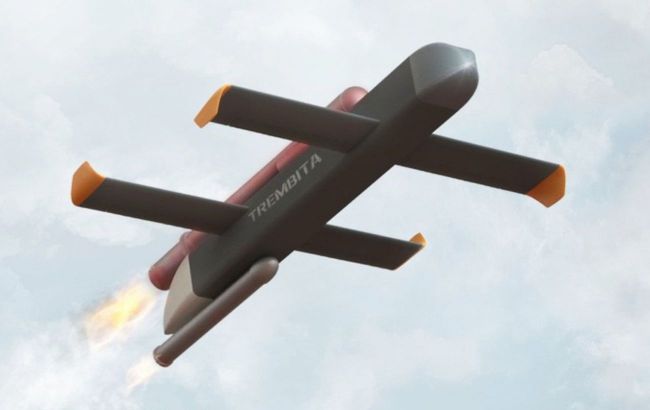Can Ukrainian-made Trembita missile reach Moscow? New details and specifications
 Photo: Visualization of the Trembita missile (facebook.com/trembita.rocket)
Photo: Visualization of the Trembita missile (facebook.com/trembita.rocket)
Ukraine is working on the creation of the Trembita cruise missile. As reported by Western media, a volunteer project is also developing a version that, in the future, could even reach Moscow.
RBC-Ukraine shares what is known about the Trembita missile and the current stage of its development.
Contents:
- Not ATACMS or Storm Shadow: What Western media are saying about the Trembita missile
- What is known about the characteristics and purpose of the Trembita
- Missile or new drone? Pros and cons of the Trembita: Expert opinion
- Will Trembita reach Moscow and when will it appear on the battlefield?
Not ATACMS or Storm Shadow: What Western media are saying about the Trembita missile
Ukraine is rushing to develop long-range weapons that it can produce and use independently. The new Trembita cruise missile may symbolize this drive for firepower autonomy.
It is not anything extraordinary, writes The Telegraph, which describes it as a modern version of the German V-1 (V-2) from World War II. The missile combines a loud impulse jet engine with a simple design, a tubular fuselage, wings, and a guidance system.
However, all of this gives the Trembita its best feature – its low cost. The basic version, which has been in development since 2023, costs only $10,000. In comparison, an American ATACMS costs over $1 million. The cost of the Trembita missile itself is around $3,000, with an additional $7,000 for the guidance system, as reported by Army Recognition in June.

Photo: The Economist showed the experimental launch of the Trembita
The Trembita is not an ATACMS, Storm Shadow, or SCALP-EG (Western missiles used by Ukraine to strike Russian targets). It does not have the power of the American missile, the penetration capability of the British and French ones, or the precision of all three. Therefore, it will not be able to hit underground command bunkers, but it is likely capable of effectively targeting ground objects, such as enemy defense industry facilities.
Details of Ukraine's missile program are shrouded in secrecy, and there is a good reason for this – Russia is hunting for its sites. The conditions of the full-scale war forced production to be moved underground. Part of the assembly has shifted to protected bunkers, while component manufacturing is spread across hundreds of hidden, nondescript locations. These include a garage where volunteer engineers are working on the Trembita.
The name Trembita refers to the Ukrainian folk instrument – the alpine horn. It is easy to understand why. In a December article, The Economist described the thunderous roar produced by the missile's engine.
"We might miss our target, but we’ll fly the thing so low above Russian trenches they will sh*t themselves,'" noted Serhii Biryukov, who heads the diverse team of developers.
The serial production of the Trembita is planned for after the final field tests. It took Ukrainian enthusiasts only a year and a half to develop it, which is a feat in a field where the journey from the drawing board to the battlefield usually takes many years, as stated in The Economist material.
What is known about the characteristics and purpose of the Trembita
The development of the Trembita became known in the spring of 2023. Engineers from the PARS volunteer design bureau, with the participation of volunteers from the Vidsich (fighting back) public organization, worked on the project. The goal was to create a small cruise missile for striking enemy targets and depleting the enemy's air defense systems.
"Our simple missile is incomparably cheaper than the shots from the enemy's anti-aircraft missile systems," say the developers.
The stated characteristics of the basic Trembita are:
- Loaded weight: 100 kg
- Warhead weight: 20 kg (thermobaric or fragmentation-fugase)
- Range: over 140 km
- Speed: over 400 km/h
- Altitude: maximum 2000 m and minimum 30 m
- Launch method: with a solid fuel booster and from a pneumatic catapult
- Fuel: the engine runs on A-92 and A-95 gasoline
- Priority targets: air defense systems, ammunition depots, and troop concentrations
The engine used in the Trembita was invented in 1864. "Such an apparently odd choice is entirely justified for the mass production of single-use shells because this engine is very simple to make, reliable, and has no moving parts," wrote Serhii Biryukov on his Facebook.
According to him, the drawbacks of this design become its advantages. In particular, the missile can be used as a decoy – a cheap false target. For this, it has a sufficient Radar Cross-Section and a noticeable thermal signature, so that Russian air defense radars can detect it.
"We want the enemy to see our missile well on their radars and be forced to treat it as a priority target for their air defense systems. Let them shoot down the Trembitas, thus exhausting their anti-aircraft resources. It's very beneficial for us to exchange a cheap missile for expensive shots from swampy air defense systems," the developer added.
In the combat version, the missiles will have more expensive electronics. In his opinion, a swarm of 30 missiles will still overcome the air defense barrier and deliver "thermobaric gifts" to the enemy's positions at depths of 100 km. The special pride of the missile is its guidance system, but it is kept secret.
Earlier, he also explained why the missile is called "folk." The reason is that the components are so simple that the production of individual parts and units can be organized in garage workshops. And such a "people's defense industry" cannot be destroyed by Russian S-300s or Kalibrs.
Missile or new drone? Pros and cons of the Trembita: Expert opinion
If the development combines an extremely cheap engine with a simple design, it is likely to meet the announced price of $3,000 for the version aimed at exhausting enemy air defense and up to $15,000 in its combat configuration (with a more complex navigation system and possibly terminal guidance), according to aviation expert Valerii Romanenko.
At the same time, he does not rule out that Trembita may be more of a strike drone than a missile. Among the advantages, he lists the high speed and the simple engine, which has been used in weaponry since 1944, when Nazi Germany attacked London and Antwerp with FAU-1 flying bombs. Additionally, the rectangular design with a simple glider and tandem wing is another benefit.
"This design was developed in our country as early as the late 1990s. It's quite stable, and for a cruise missile, maneuverability is not as critical. It needs to make simple turns, and competing with anti-aircraft interceptors is unnecessary," he explained in a comment to RBC-Ukraine.
Regarding speed and range, the expert suggests that the claimed characteristics in the experimental samples are likely to be improved. He also doesn't rule out the possibility of adding a penetrative warhead for targeting protected objects or a cluster warhead for strikes on runways.
"If there is a sufficiently large warhead (currently not very large), it will be possible to disable airfields and immobilize the enemy's aviation," the expert emphasized.
However, the simplicity of the design comes with a cost in terms of flight range. One of the major drawbacks appears to be the high fuel consumption. "If we look at photos of the sample, there are winglets that can increase the range by 5-7%. But from an aerodynamic perspective, everything that can be squeezed from this design has already been," explained Romanenko.
Another downside he mentions is the instability of the engine's performance. The pulsed air-breathing engine uses a combustion chamber with inlet valves and an exhaust nozzle. Fuel and air are supplied intermittently, and the ignition-explosion cycles can cause shaking during flight.
"Because of this, it's difficult to predict how complex radio-electronic equipment, especially inertial navigation with sensitive laser gyroscopes, will behave. This could be a problem. Perhaps Trembita only has satellite navigation, which is insufficient for precise targeting. I hope they will manage to install a terminal guidance system, which will significantly improve its capabilities," the expert added.
Will Trembita reach Moscow and when will it appear on the battlefield?
Developers from PARS are working on a longer-range version of Trembita. It is expected to have a range of 650 km, meaning it could reach Moscow.
"That version, which should be ready in around a year, would undoubtedly cost more than $10,000 – but would still be potentially the cheapest deep-strike munition in the world," writes The Telegraph.
It is still unclear how the Trembita will be modified in this version. According to Romanenko, the engine is the core, so it will remain the same. Increasing its range can be done by reducing the mass of the warhead, but in this case, that would not be practical.
"In the base version, it already weighs between 20 and 30 kg. And this is the entire warhead, not just the explosive. So, it's more reasonable to increase its mass. If we want to hit industrial facilities, we need 50 kg, preferably more," he explained.
Today, Prime Minister Denys Shmyhal announced that Ukraine plans to produce around 3,000 cruise missiles and missile drones in 2025, and intends to sign contracts with manufacturers for 3-5 years. It is unclear whether the developers of Trembita will be among them, as there has been no official communication from the government regarding this missile.
Given the pace of development, it is possible that Trembita will begin to be used for strikes on Russian targets this year. However, it still needs further development, as only the engine testing has been demonstrated so far.
"Apparently, the declared performance characteristics have been stated, but full missile tests are needed to confirm them. And if we want to strike beyond 200 km, these tests will take time. Moreover, the range needs to be extended by increasing the size, as more fuel is required. The longer the range, the more precise the navigation needs to be, as well as reliable countermeasures against enemy electronic warfare systems," noted Romanenko.
The figure of 3,000 missiles per year is quite high. Especially considering that the enemy, according to maximum estimates, fires up to 150 missiles per month, or 1,800 per year. Therefore, Ukraine will likely reach the target figure with projects like Ruta, Palianytsia, Peklo, and, most likely, rockets for multiple rocket launch systems (MRLS), according to the expert.
Sources: materials from The Telegraph, The Economist, Army Recognition, Facebook posts by the leader of the Trembita development team, Serhii Biryukov, and comments from Valerii Romanenko, a leading researcher at the National Aviation University and aviation expert.

